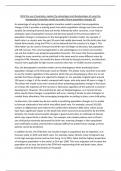With the use of examples, explain the advantages and disadvantages of using the
demographic transition model to predict future population changes [8]
An advantage of using the demographic transition model to predict future population
change is that it provides a starting point from which population change over time can be
studied. By showing historical data and trends followed by other countries, it can help to
anticipate rates of population increase and decrease based on the previous pattern of
population change in comparison to the demographic transition model. For example, if
death rate in a country over the past 20 years had rapidly decreased, but the birth rates had
stayed fairly steady, using the DTM, it can be deduced that the country is in stage 2. This
information can be used to forecast that birth rates will begin to decrease, but population
will still increase. This universal application is also advantageous as it means all countries
can use the model to see projected population forecasts. This mean that future population
change for many countries can be predicted in the same way for many different areas by
using the DTM. However, the model has been criticised for being Eurocentric, and therefore
may be more applicable to high income countries than low- or middle-income countries.
Also, the demographic transition model can be advantageous when predicting future
population change as the timescales used are flexible. This allows many countries to be able
to use the model, regardless of the speed at which they are developing as there are no set
periods that these changes are expected to happen in. For example, England spent around
130 years in stage 2 of the model, compared with Japan, who only spent 40 years in stage 2.
This allows the model to be more universal when predicting population change in the future
as it shows the trajectory of the increase or decreases regardless of the speed of a country's
development. However, this could also be seen as disadvantageous, as it cannot tell you
when exactly these changes in population will occur, making it harder to plan strategies to
combat these alterations, like encouraging immigration or putting in place a one child policy.
Furthermore, the model may be less useful in predicting population changes as it is unable
to forecast outbreaks of war which may affect death rate. For example, around 241,000
civilians in Afghanistan were killed in the conflict there between 2003-2021, which would
have had a significant impact on the death toll, which cannot be accounted for by the DTM.
Similarly, the model cannot predict changes in government policy or outbreaks of disease
which may impact birth or death rates. For example, anti-natalist policies such as China’s
one child policy massively decreased the birth rate, meaning changes in their population
were artificially created, and therefore making it difficult to predict future change as these
policies cannot be predicted.
In addition to this, the DTM does not include changes in population due to migration, as it
focusses solely on birth and death rates. For example, Qatar attracts many immigrants due
to the high average income and tax-free living. As of 2015, Qatar had the highest proportion
of immigrant population in the world, at 56.4 per 1000. This mass migration will increase the
population of an area, but due to the DTM only representing birth and death rates, these
changes cannot be demonstrated on the graph.




